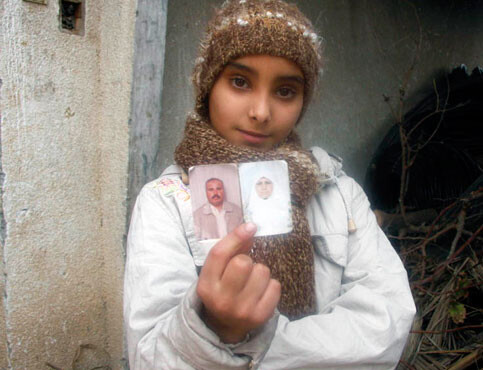The Electronic Intifada 3 February 2010

Mona al-Samouni shows a photo of her parents who she witnessed being killed in Israel’s assault on Gaza in January 2009. (Suhair Karam/IRIN)
OCCUPIED GAZA STRIP (IRIN) - Mona al-Samouni, 12, is depressed and has nightmares about the day — just more than a year ago — when she witnessed her parents and a number of relatives being shot by Israeli soldiers in their home in Zeitoun, southeast of Gaza City.
Like a number of other children who witnessed horrific events during last year’s 23-day Israeli military operation in the Gaza Strip, Mona has become increasingly withdrawn and silent — common ways of coping with tragedies, doctors say.
Statistics about Palestinians who lost their life during the military operation vary, but nongovernmental organizations (NGOs) place the overall number of persons killed between 1,387 and 1,417. The Gaza authorities report 1,444 fatal casualties, while Israel provides a figure of 1,166, according to the UN Fact-Finding Mission on the Gaza Conflict, also known as the Goldstone report.
The killing of Mona’s family is one of the most notorious incidents of last year’s conflict in Gaza and was one of 11 incidents investigated by the UN mission “in which Israeli forces launched direct attacks against civilians with lethal outcome” and in which “the facts indicate no justifiable military objective pursued by the attack.” It said Israeli forces “killed 23 members of the extended al-Samouni family” on that day.
“There is a significant deterioration in the psychological well-being of Palestinian children who are living in the Gaza Strip, especially after the recent war,” Ayesh Samour, director of the Psychiatric Hospital in Gaza, told IRIN.
According to a study by NGO Ard al-Insan in Gaza, 73 percent of Gaza children are still suffering from psychological and behavioral disorders, including psychological trauma, nightmares, involuntary urination, high blood pressure and diabetes.
Samour said children in Gaza were being denied a normal childhood because of the insecurity and instability in their environment. He said a culture of violence and death had pervaded their mentalities, making them angrier and more aggressive.
A dearth of health professionals in the Strip and a lack of access to medical equipment meant children were not getting the help they needed, Samour said.
Basem Naim, the Hamas minister of health in Gaza, said hospitals and primary care facilities damaged during the Gaza conflict have not been rebuilt due to the blockade of the territory under which Israel bans the entry of construction materials, saying they could be used for military purposes.
“Health professionals in Gaza have been cut off from the outside world,” Naim said.
Hussain Ashour, director of al-Shifa Hospital, the main hospital in Gaza City, said they lacked medical equipment and pediatricians.
Project
Save the Children Sweden and the UN Children’s Fund (UNICEF) on 25 January launched the Family Centers Project in Gaza.
“The project will ensure that the right to survival and development of children at risk … is ensured through the establishment of 20 Family Centers in different communities of the Gaza Strip,” Patricia Hoyos, director of Save the Children in Gaza, told IRIN.
“Its main role is to serve a wide population and to provide quality child protection, educational, health and psychosocial services to all those in need of support,” she said.
This item comes to you via IRIN, a UN humanitarian news and information service, but may not necessarily reflect the views of the United Nations or its agencies. All IRIN material may be reposted or reprinted free-of-charge; refer to the copyright page for conditions of use. IRIN is a project of the UN Office for the Coordination of Humanitarian Affairs.


